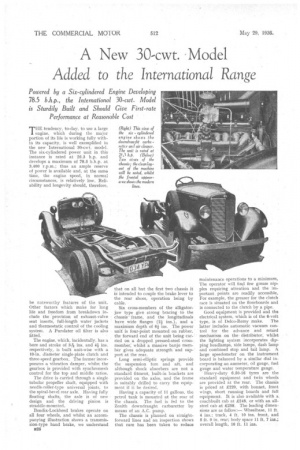A New 30-cwt, Model
Page 40

If you've noticed an error in this article please click here to report it so we can fix it.
Added to the International Range THE.tendency, to-day, to use a large engine, which durin.g the major portion of its life is working fully within its capacity, is well exemplified in the new International 30-cwt. model. The six-cylindered power unit in this instance is rated at 26.3 h.p. and develops a maximum of 78.5 b.h.p. at 3,400 r.p.m.; thus an ample reserve of power is available and, at the same time, the engine speed, in normal circumstances, is relatively low. Reliability and longevity should, therefore, be noteworthy features of the unit. Other factors which make for long life and freedom from breakdown include the 'provision of exhaust-valve seat inserts, full-length water jackets and thermostatic control of the cooling system. A Purolater oil filter is also fitted.
The engine, which, incidentally, has a bore and stroke of 3T4g ins. and 4-i ins. respectively, is built unit-wise with a 10-in, diameter single-plate clutch and three-speed gearbox. The former incorporates a vibration damper, whilst the gearbox is provided with synchromesh control for the top and middle ratios.
The drive is carried through a single tubular propeller shaft, equipped with needle-roller-type universal joints, to the spiral-bevel rear axle. Having fully floating shafts, the axle is of new design and the driving pinion is straddle-mounted.
Bendix-Lockheed brakes operate on all four wheels, and whilst an accompanying illustration shows a transmission-type hand brake, we understand B26 that on all but the first two chassis it is intended to couple the brake lever to the rear shoes, operation being by cable. • Six cross-members of the alligatorjaw type give strong bracing to the chassis frame, and the longitudinals have wide flanges (2iins.), and a " maximum depth of 6i• ins.. The power unit is four-point mounted on rubber, the •forward end of the unit being•carried on a dropped pressed-steel -crossmember, whilst a massive banjo member gives adequate strength and support at the rear.
Long semi-elliptic springs provide time suspension fore and aft, and although shock absorbers are not a standard fitment, built-in brackets are provided on the axles, and the frame is suitably drilled to carry the equipment if it be desired.
Having a capacity of II gallons, the petrol tank is mounted at the rear of the chassis. The fuel is fed to the Zenith downdraught carburetter by means of an A.C. pump. • The chassis is planned on straightforward lines and an inspection shows that care has been taken to reduce maintenance operations to a minimum. The operator will find few grease nipples requiring attention and the insportant points are readily accessible. For example, the greaser for the clutch race is situated on the floorboards and is connected to the clutch by a pipe.
Good equipment is provided and the electrical system, which is of the 6-volt type, is of Delco-Remy make. The latter includes automatic vacuum control for the advance and retard mechanism on thedistributor, whilst the lighting system incorporates dipping headlamps, side lamps, dash lamp and combined stop and tail lamp. A large speedometer on the instrument board is balanced by a similar dial incorporating an ammeter, oil gauge, fuel gauge and water temperature gauge.
Heavy-duty 6.50-16 tyres are the standard equipment and twin wheels are provided at the rear. The chassis is priced at £220, with bonnet, front wings, short running boards and full equipment. It is also available with a, coachbuilt cab at £248, or with an allsteel cab at £258. The leading dimensions are as follow:— Wheelbase, 11 ft.
4 ins.; track, 4 ft. 10 ins, front, and 5 ft. 0 in, rear; body space 11 ft, 7 ins.; overall length, 16 ft. 11 ins.




























































































